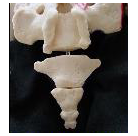How to Decide about Tailbone Removal (Coccyx Removal Surgery, Coccygectomy) for Tailbone Pain |
|
For patients suffering with Tailbone Pain (coccyx pain), it can be a very difficult decision whether to consider surgery to remove the tailbone (coccyx removal surgery, also called coccygectomy). Although in my medical practice I specialize in treating tailbone pain without the use of surgery, I do refer probably one out of every 15-20 tailbone patients for surgical consultation. This article will focus on helping patients and their doctors decide whether to consider tailbone removal surgery, as part of the treatment of tailbone pain.
Step 1
The best first step is to find out what is causing the tailbone pain. Ideally this is done by seeing a physician with experience in evaluating and treating a variety of causes of tailbone pain. Tailbone pain can be caused by many different conditions, such as: coccyx fractures (fractured tailbone, “broken tailbone”, chipped tailbone, “cracked tailbone”), coccyx dislocations (dislocated tailbone), coccyx sprains (sprained tailbone), coccyx injuries from pregnancy (tailbone injuries while pregnant or from childbirth, labor and delivery), tailbone injuries from sports and other causes (bruised tailbone from trauma) and tailbone pain, aching, soreness or tailbone discomfort that began without any trauma or injury at all. By knowing the cause of the tailbone pain, the physician can give individualized advice or treatment to help decrease the pain without surgery.
Step 2
In cases where the tailbone pain is caused by cancer (tumor, malignancy), surgical removal might be the best treatment, if recommended by your doctor. However, fortunately, the vast majority of cases of tailbone pain are NOT caused by cancer.
Step 3
Web Search for Tailbone Doctor Web Search for Tailbone Doctor Before considering tailbone removal surgery, it usually makes sense to first try non-surgical treatments for tailbone pain.
Step 4
Non-surgical treatments available without a physician include using tailbone cushions (wedge cushions and/or donut cushions), taking over-the-counter (non-prescription) medications by mouth, and using caution to avoid exacerbations of tailbone pain (e.g., by avoiding sitting on surfaces that worsen the pain).
Step 5
Non-surgical treatments available through a physician (medical doctor) include prescription strength medications (to relieve pain and/or decrease inflammation), either taken by mouth or applied topically to the skin over the tailbone. Also, a physician with experience treating coccyx pain can perform local injections at the tailbone region, such as nerve blocks and/or injections of anti-inflammatory medications (e.g., steroids similar to cortisone). Ideally, injections in the coccyx region are performed under fluoroscopic guidance (rather than “blind” injections), so that the physician can more precisely place the medication at the correct location (and avoid accidentally placing the needle into other pelvic structures). There are new/current injection techniques that were not available a few years ago.
Step 6
Fortunately, the majority of patients with tailbone pain will get relief through the steps above. But for the small percentage of patients who have gone through the above steps yet still have severe tailbone pain substantially compromising their quality of life, it may be reasonable to consider surgery to remove the tailbone (coccyx removal surgery, coccygectomy).
Step 7
Prior to proceeding with surgery, make sure to find a surgeon who has substantial experience in performing this particular surgery. Experience matters.
Step 8
Make a list of questions to ask the surgeon, including asking about risks, benefits, and the surgeon’s experience and expected outcomes.
Step 9
Consider the potential benefits of the surgery. Despite the multiple potential risks (including those noted below), if patients are properly selected and if the surgeon is experienced at performing this particular (uncommon) surgery, the tailbone pain is improved in at least 2 out of 3 patients who have the tailbone removed.
Step 10
Make sure to consider all of the risks of the surgery. Current publications of medical research (since 2000) have noted that even after undergoing the surgery as many as 1 out of every 3 patients may have pain that is still not relieved. Also, almost 20% of coccygectomy surgeries may be complicated by infections (requiring repeat surgery in 15% of patients who have the coccygectomy surgery). Some patients have postoperative pain (pain after surgery) that lasts as long as one year. Patients may be at risk for prolapse (sagging) of the pelvic floor.
Step 11
In summary, consider the medical advice often published by both surgeons and non-surgical physicians, both of whom often refer to coccygectomy as “a last resort.” Specifically, tailbone removal surgery may indeed be helpful for the small percentage of patients who fail to get adequate relief from first trying all of the non-surgical treatments (including current injection techniques). Doctors often recommend coccygectomy for coccyx pain only if patients have first tried the spectrum of non-surgical treatments.
Tips & Warnings
* For more information on Tailbone pain, please see Dr. Foye’s other TailboneDoctor articles on eHow, or go to www.TailboneDoctor.com and www.Tailbone.info
* WARNING: Coccyx pain can sometimes be due to very serious underlying medical conditions: seek in-person evaluation by a medical professional.
* WARNING: This information is intended to be educational and is NOT to be considered as medical advice. This information is NOT a substitute for direct medical care from a physician who evaluates you in person. * WARNING: Many physicians and other health providers have little or no experience in evaluating or treating tailbone pain or coccyx injuries. Seek medical attention from a specialist with experience in treating tailbone pain. |
